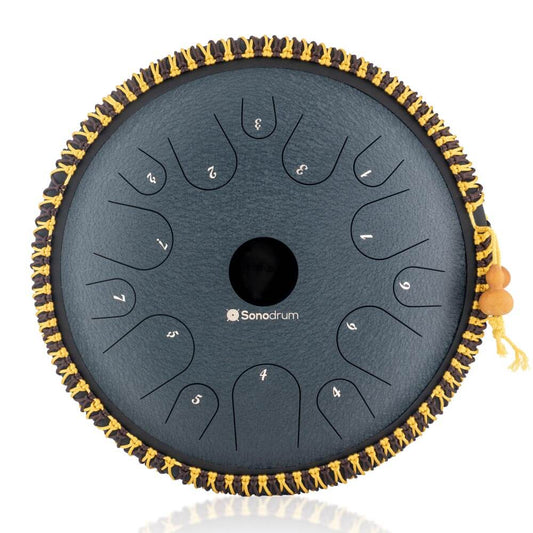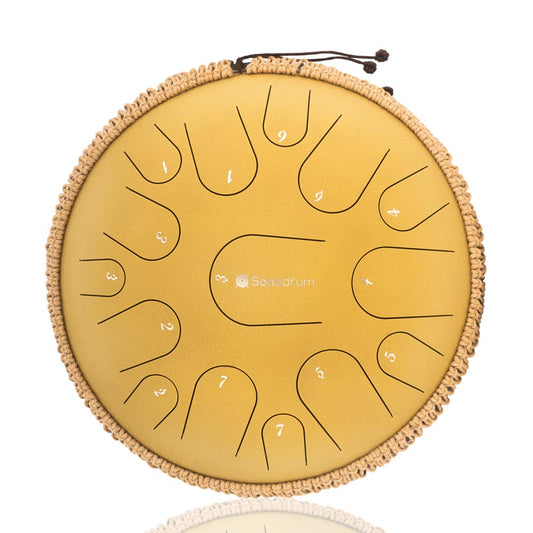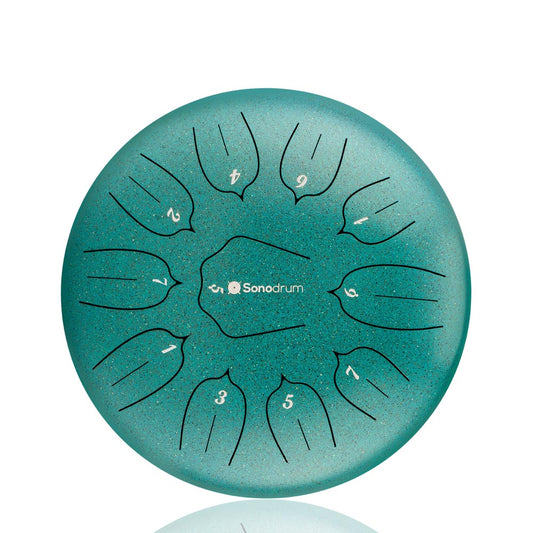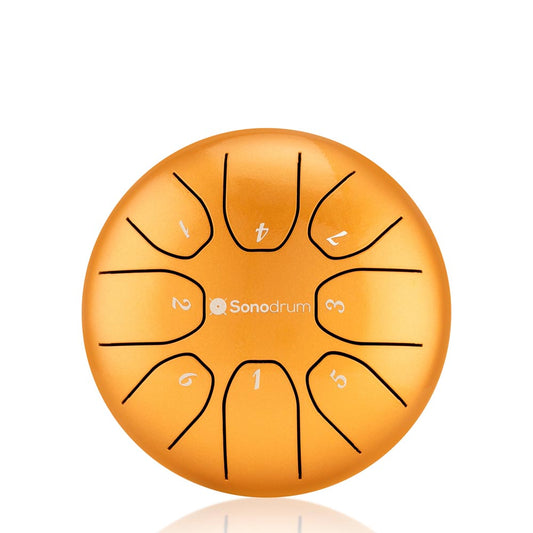The tongue drum is emerging as a revolutionary tool in the realm of sound therapy, allowing therapists to harness the healing potential of music therapy to benefit their clients. By creating tranquil soundscapes, the tongue drum fosters a serene environment that encourages emotional release and deep relaxation. This innovative instrument not only enhances the therapeutic experience but also bridges the connection between therapists and clients. As we dive deeper, we'll explore the profound impacts of sound therapy and practical applications for integrating the tongue drum into therapeutic practices.
Key Takeaways
- The tongue drum is an innovative tool in sound therapy.
- It helps promote healing through musical engagement.
- Therapists can enhance emotional release with this unique instrument.
- Integrating the tongue drum builds stronger client-therapist connections.
- The use of sound therapy is on the rise in therapeutic practices.
- Creating a peaceful atmosphere is essential for therapeutic success.
The Healing Benefits of Sound Therapy
Sound therapy offers a unique method for experiencing healing through sound. By utilizing various vibrations and frequencies, this therapeutic approach taps into our innate connection with sound for emotional and physical wellness. Through an understanding of the principles behind sound therapy, it becomes clear how this practice has gained popularity among mental health practitioners and wellness enthusiasts alike.
Understanding Sound Therapy
At its core, sound therapy revolves around the idea that specific sound frequencies can profoundly affect our mental and emotional states. Different sounds can resonate with various parts of our being, fostering a sense of harmony and balance. This practice harnesses vibrations to create an environment conducive to relaxation and restoration, promoting an overall sense of well-being.
The Science Behind Sound Frequencies
Scientific research reveals that sound frequencies can stimulate brain activity in ways that impact mood and emotional responses. Frequencies like binaural beats or those produced by instruments can activate specific neural pathways, encouraging a state of calm or helping to alleviate anxiety. Understanding the science behind these sound frequencies enhances the appreciation of the sound therapy benefits.
Benefits for Mental Health
The application of sound therapy extends to various aspects of mental health. Therapeutic sound practices can lead to:
- Reduced anxiety: Participants often experience a calmness that allows for a decrease in anxious feelings.
- Improved mood: Sound therapies can trigger positive emotional responses, raising motivation and satisfaction.
- Enhanced focus: Utilizing sound can help clear mental clutter, making it easier to concentrate.
Exploring sound therapy methods offers exciting possibilities for individuals seeking relief and enhancement in their mental health journeys.
For Therapists: Using the Tongue Drum in Sound and Breath Therapy
Therapists seeking innovative ways to enhance their sessions can find great value in integrating tongue drums. These instruments not only offer unique soundscapes but also create opportunities for deeper client connection. Through effective therapist techniques, the use of the tongue drum can facilitate a calming environment, which is crucial for breath therapy. By evoking emotional responses during sessions, the tongue drum becomes more than a musical instrument; it transforms into a therapeutic tool.
Integrating Tongue Drums into Therapy Sessions
Incorporating tongue drums into therapy sessions allows therapists to explore various sounds that resonate with clients. This practice can help reduce anxiety and encourage relaxation, making it easier for clients to express their feelings. Therapist techniques might include playing soft melodies while guiding clients through breathing exercises or using rhythmic patterns to assist in meditation. These methods not only support breath therapy but also enhance the overall experience of the session.
Enhancing Client-therapist Connections
Creating a solid client connection is vital in a therapeutic setting. The use of tongue drums can significantly aid in building rapport. When clients respond to the soothing tones, they may feel more at ease, fostering an open line of communication. This emotional engagement can lead to profound breakthroughs during therapy. By actively integrating tongue drums, therapists can cultivate an atmosphere that promotes trust and safety, essential for effective healing.
Types of Tongue Drums and Their Unique Qualities
Exploring the various types of tongue drums available on the market reveals a rich array of options suitable for different therapeutic needs. Each drum, crafted from distinct tongue drum materials, offers unique sound qualities and emotional resonances, making them essential tools for effective sound therapy. Understanding these elements plays a vital role in selecting a tongue drum that aligns with your therapeutic goals and the preferences of your clients.
Diverse Materials and Their Resonance
Different tongue drum materials significantly influence the sound and vibe of each instrument. The most common materials include:
- Steel: Known for its durability and bright tones, steel tongue drums produce a clear, resonant sound that appeals to many therapeutic practices.
- Wood: Wooden tongue drums create a warm, mellow sound, often preferred for relaxation and meditative sessions.
- Aluminium: This lightweight material provides a unique tonal quality, offering a blend of brightness and warmth.
When considering types of tongue drums, the material affects not only the sound but also the malleability of the drum, influencing how it can be played and incorporated into therapy. The choice of material should resonate with the intended emotional outcome of each therapy session.
Choosing the Right Drum for Your Practice
Selecting a tongue drum that complements your therapeutic practice involves several considerations. Here are key points to bear in mind:
- Therapeutic Goals: Reflect on what you want to achieve. A steel drum might suit energetic sessions, while wooden drums may create a serene atmosphere.
- Client Preferences: Engage with clients about their sound preferences. Their comfort can be pivotal in enhancing the therapeutic experience.
- Size and Portability: Consider if the drum will be used in a fixed setting or needs to be portable. Smaller drums can be advantageous for mobility.
Popular brands such as HAPI Drums and Thomann offer various options catering to diverse needs, making the selection process even more accessible. Prioritize these factors to ensure that your choice in selecting a tongue drum enhances the therapeutic journey you provide.

Techniques for Playing the Tongue Drum
Mastering tongue drum techniques is essential for therapists aiming to enhance their sessions. Understanding basic and advanced methods of playing tongue drums enables a therapist to create a calming presence while conducting therapy. This section delves into foundational techniques, advanced skills, and strategies for fostering a therapeutic atmosphere.
Basic Playing Techniques
Learning the fundamentals of playing tongue drums lays the groundwork for effective therapy. Key aspects include:
- Hand Positioning: Ensure a relaxed, yet controlled grip on the mallets, allowing fluid movement.
- Striking Methods: Use gentle taps, varying velocity to create different tonal qualities. Experiment with angles to discover distinctive sounds.
- Rhythm Exploration: Familiarize yourself with simple rhythmic patterns to keep the pace engaging while ensuring it aligns with therapy goals.
Advanced Techniques for Therapists
As therapists gain confidence, they can explore more complex tongue drum techniques. Consider the following:
- Layering Sounds: Combine multiple rhythms and melodies for richer harmonic experiences.
- Interactive Playing: Encourage clients to participate by creating call-and-response patterns.
- Dynamic Control: Manipulate volume and intensity to evoke emotions and support the therapeutic process.
Creating a Peaceful Atmosphere
Incorporating sound into therapy can create a serene environment conducive to relaxation. Strategies to consider include:
- Light and Space: Select a tranquil setting, ensuring the lighting complements the auditory experience.
- Consistent Timing: Set a predictable rhythm as a foundation for relaxation, encouraging clients to release tension.
- Mindful Breathing: Integrate breath-focused practices alongside playing to deepen the connection between the sound and healing.
Case Studies: Tongue Drums in Therapeutic Settings
The integration of tongue drums in therapeutic settings has garnered interest due to their positive impact on client experiences. Various therapists have shared successful case studies, illustrating how these unique instruments enhance emotional healing and build strong connections with clients. Highlighting real-world applications fosters a deeper understanding of the therapeutic success achieved through musical interventions.
Success Stories from Therapists
Numerous therapists have reported transformative experiences when incorporating case studies tongue drums into their practices. For example, one therapist working with children diagnosed with autism observed significant improvements in communication and emotional expression through guided drum sessions. Clients who were previously withdrawn began to engage more actively with both the drum and their surroundings.
In another instance, a therapist using tongue drums with elderly patients noted enhanced relaxation and reduced anxiety levels in individuals suffering from memory-related issues. Clients expressed a newfound sense of calm, explaining that the soothing sounds allowed them to connect with their feelings and the present moment.
Building Client Trust and Comfort
Client comfort plays a crucial role in the therapeutic relationship. Therapists utilizing tongue drums have observed a marked increase in trust among their clients. The non-intrusive nature of music helps to break down barriers and create a safe environment for open communication. Clients have expressed feeling more at ease, enabling them to address deeper emotional concerns.
The following table outlines specific examples of therapeutic success linked to the use of tongue drums:
| Therapeutic Setting | Client Group | Reported Benefits |
|---|---|---|
| Children's therapy | Autism spectrum | Improved communication, increased engagement |
| Geriatric therapy | Memory care | Reduced anxiety, enhanced emotional expression |
| Group therapy | Trauma survivors | Strengthened connections, collaborative healing |
Conclusion
In summary, the therapeutic benefits of tongue drums offer a rich avenue for therapists seeking to enhance their sound and breath therapy practices. Through effective integration of this unique instrument, practitioners can create a soothing environment that promotes relaxation and emotional healing. The sound therapy impact of tongue drums has been underscored by numerous case studies, highlighting the profound connection between sound, breath, and mental well-being.
As explored in this article, the healing through music not only facilitates deeper client-therapist connections but also fosters an atmosphere where clients feel secure and open to experiencing their emotions. By incorporating tongue drums into sessions, therapists can harness the transformative potential that sound therapy delivers, ultimately enhancing the healing journey of their clients.
Now is the time for therapists to experiment with the power of tongue drums in their practices. Embrace this harmonious tool and observe the remarkable benefits it can bring, transforming your therapeutic approach and creating a positive impact in your clients' lives.
FAQ
What is a tongue drum and how is it used in therapy?
A tongue drum is a percussion instrument that produces soothing melodies when struck. In therapy, it is used to create a calm atmosphere, facilitating emotional release and enhancing relaxation during sessions.
How does sound therapy benefit mental health?
Sound therapy has been shown to reduce anxiety, improve mood, and enhance overall mental well-being by stimulating brain activity through specific sound frequencies, which can evoke emotional responses.
Can I integrate the tongue drum into my existing therapy practice?
Absolutely! Incorporating the tongue drum can deepen client-therapist connections and create a safe space that fosters trust and relaxation, enhancing the overall therapeutic experience.
What types of tongue drums are available and which should I choose?
Tongue drums come in various materials such as steel and wood, each affecting sound quality. When selecting one, consider your therapeutic goals, the preferences of your clients, and the type of emotional resonance you aim to achieve in sessions.
What are some basic techniques for playing the tongue drum?
Basic techniques include proper hand positioning, striking methods, and focusing on rhythm. These foundational skills will help you create a serene musical atmosphere that enhances the therapeutic process.
Are there advanced techniques I should learn for effective use of the tongue drum?
Yes, advanced techniques involve intricate rhythms and harmonies that can be utilized to optimize client relaxation and emotional exploration during sessions. Mastery of these techniques can elevate your practice significantly.
What evidence exists to support the use of tongue drums in therapy?
Numerous case studies and testimonials from therapists demonstrate the effectiveness of tongue drums in clinical settings, showcasing how they enhance emotional healing and strengthen the bond between therapist and client.




